Let's talk about the characteristics of Excel 'table”
This article brings you relevant knowledge about excel, which mainly organizes issues related to the characteristics of l "table". By creating "table", you can easily group and group data. Analysis, and can filter, sort and other operations on the data in the "table" independently of the data in other rows and columns in the worksheet. Let's take a look at it together. I hope it will be helpful to everyone.

Related learning recommendations: excel tutorial
In Excel, you can easily group and group data by creating "tables" Analysis, and can filter, sort and other operations on the data in the "table" independently of the data in other rows and columns in the worksheet. In addition, "Table" also has some features that regular tables do not have, such as fixed title rows, automatic expansion of table areas, automatic filling of formulas, etc. Add-ins such as Power Query and Power Pivot also rely on "Table".
Next, the editor will lead you to learn about the "table" function of Excel 2019. In order to facilitate the distinction, except for the button names in the ribbon, other parts of the article are referred to as "super tables" to refer to this special "table".
Creating a "Super Table"
The steps to create a "Super Table" are as follows.
Select the object, which is the cell area to be generated as a "super table", such as the A1:B9 cell area shown in Figure 1-1. If there are no empty rows or columns in the entire data area, you can select any non-empty cell (such as A4) as the selected object.

Click the [Format Table] drop-down button under the [Home] tab, and select any table style in the extended menu, as shown in Figure 1-2 Show.
You can also click the [Table] button under the [Insert] tab, as shown in Figure 1-2. Or press
Retain the default settings in the pop-up [Create Table] dialog box, and then click the [OK] button to generate a "super table", as shown in Figure 1-3.
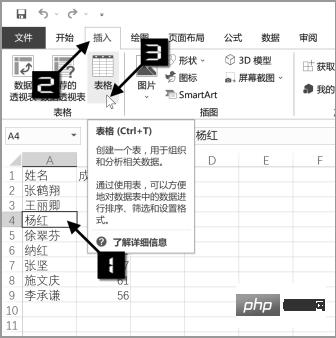
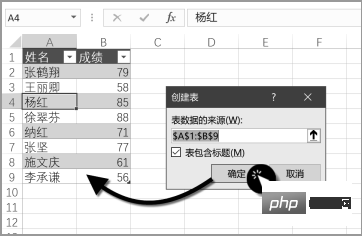
Features of "Super Table"
Super table has the following characteristics.
There is one and only one title row. The content of the title row is in text format and has no repetitions. The original field titles are repeated. Titles that appear multiple times will be distinguished by numbers.
Automatically apply table styles.
All merged cells are automatically unmerged, and the original content is displayed in the first cell in the upper left corner of the original merged area.
Select any cell in the "Super Table" and scroll down the worksheet, the table title automatically replaces the column label of the worksheet, as shown in Figure 1-4.
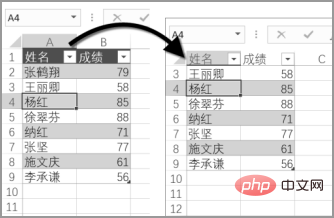
The title row automatically adds a [Filter] button, and you can also insert a [Slicer] on the basis of the "Super Table" to quickly filter the data, such as As shown in Figure 1-5.
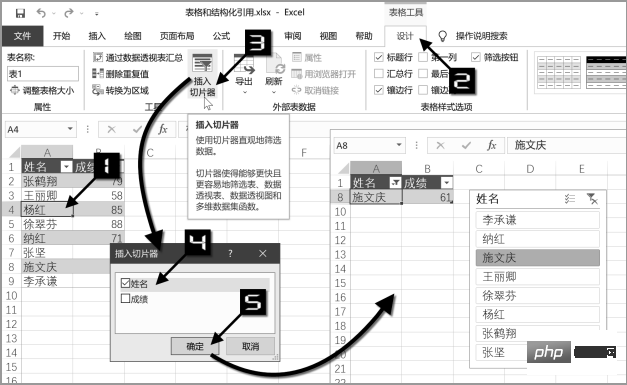
Changes in the application scope of "Super Table"
There is an application scope mark in the lower right corner of "Super Table", as shown by the arrow in Figure 1-6 At the pointed position, drag and drop this mark with the mouse to adjust the application range of the "Super Table".
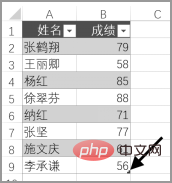
Another adjustment method is to click the [Adjust Table Size] button under the [Table Tools] [Design] tab, and in the pop-up [Reset Table Size] Respecify the table range in the dialog box, as shown in Figure 1-7.
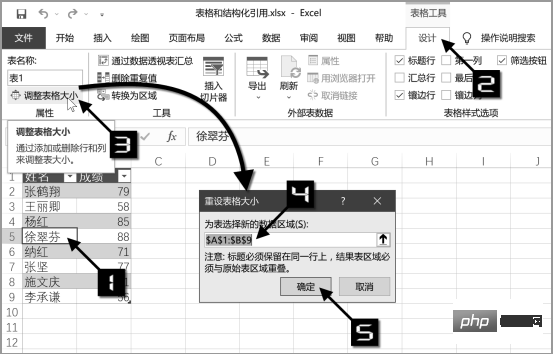
The application scope of "Super Table" can be automatically expanded. Enter content in any cell adjacent to "Super Table" on the right side or below of "Super Table" , the size of the SuperTable automatically expands to include cells with new input content. The newly expanded column will automatically add a title. If the original title content is [Custom Sequence], the new title content will be automatically generated according to the sequence rules. Otherwise, the default title of "Column Number" will be automatically generated.
Clearing the contents of the entire row or column will not cause the scope of the "Super Table" to be automatically reduced. If you need to reduce the scope of the "Super Table", in addition to dragging and dropping the application range mark with the mouse and adjusting the table size, You can also use the [Delete Column] or [Delete Row] function.
Calculation of "Super Table"
1. Calculated Column
"Super Table" enables the calculated column function by default.
If you enter a formula in any cell in the adjacent column on the right side of the "Super Table", the "Super Table" area will not only automatically expand, but also automatically apply the formula to all cells in the column, as shown in Figure 1-8. Show.
For the newly added calculated column, a smart mark of [AutoCorrect Options] will appear. Users can modify the settings as needed, as shown in Figure 1-9
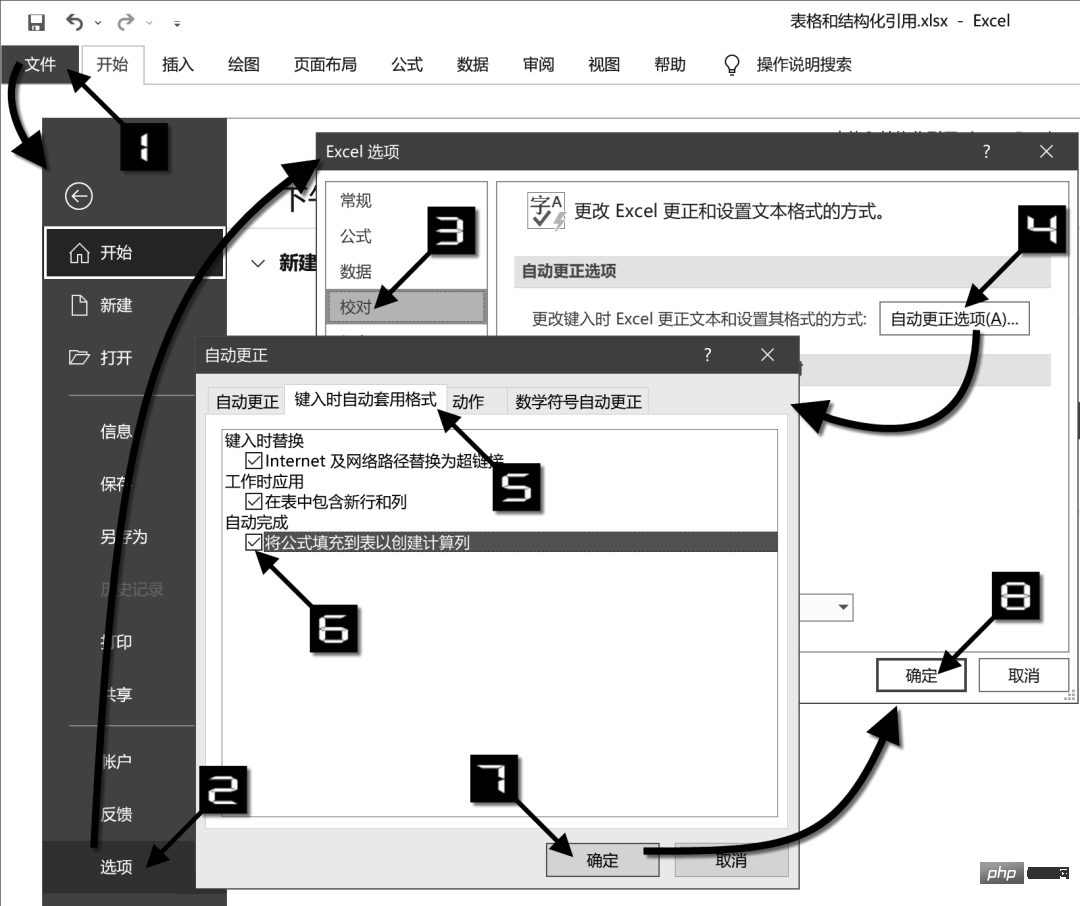

The table size of "Super Table" can automatically expand with the data. For example, if you create a PivotTable and a chart using SuperTable as the data source, when you add data to the SuperTable, the data source range of the chart and PivotTable will automatically expand accordingly.
If this function fails due to some misoperation, you can click [File] → [Options] to open the [Excel Options] dialog box. Then click the [Proofing] → [AutoCorrect Options] command to open the [AutoCorrect] dialog box. Under the [Autoformat as you type] tab, select the [Fill formulas into table to create calculated columns] check box. , and finally click the [OK] button, as shown in Figure 1-10.

2. Summary row
You can use the [Summary row] function in "Super Table".
Select any cell in the "Super Table", select the [Summary Row] checkbox under the [Design] tab of [Table Tools], and the "Super Table" will automatically add a "Summary" row. The default summary method is summation, as shown in Figure 1-11.
Click the cell in the summary row, and a drop-down button will appear. You can select different summary methods in the drop-down list, and Excel will automatically generate the corresponding formula, as shown in Figure 1-12.

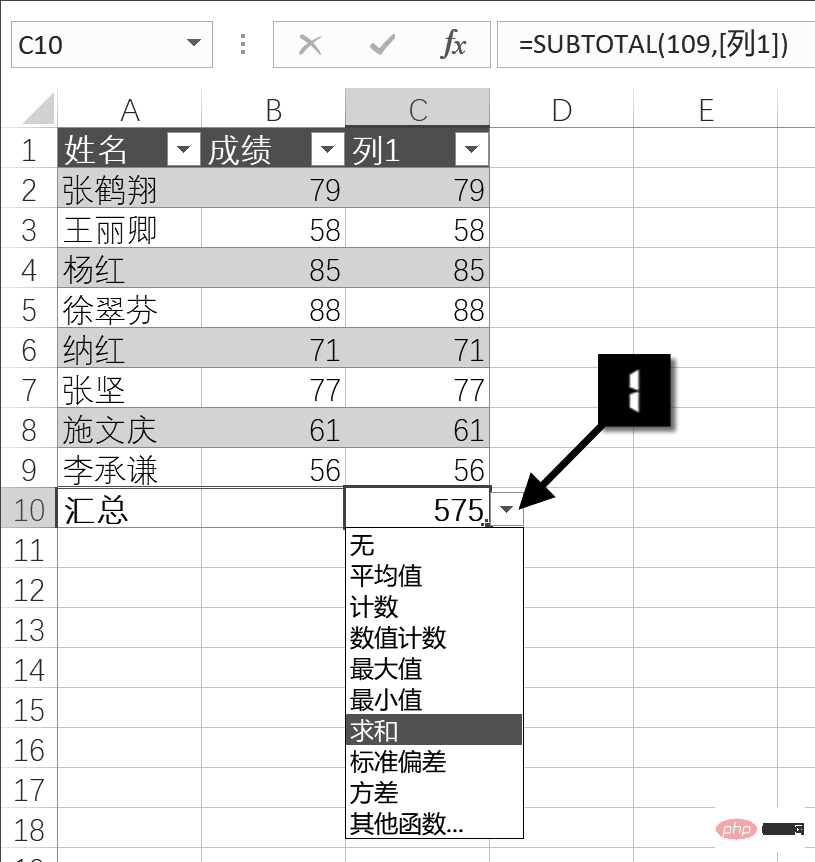
After adding a summary row, if you enter content in the lower cell adjacent to the "Super Table", it will not automatically Expand the application scope of "Super Table". At this time, you can click the cell of the last data record in the "Super Table" (the row above the summary row), such as cell C9 in Figure 1-12, press the button to add a new row to the table, and summarize the formula in the row The reference scope is also automatically extended.
Related learning recommendations: excel tutorial
The above is the detailed content of Let's talk about the characteristics of Excel 'table”. For more information, please follow other related articles on the PHP Chinese website!

Hot AI Tools

Undresser.AI Undress
AI-powered app for creating realistic nude photos

AI Clothes Remover
Online AI tool for removing clothes from photos.

Undress AI Tool
Undress images for free

Clothoff.io
AI clothes remover

Video Face Swap
Swap faces in any video effortlessly with our completely free AI face swap tool!

Hot Article

Hot Tools

Notepad++7.3.1
Easy-to-use and free code editor

SublimeText3 Chinese version
Chinese version, very easy to use

Zend Studio 13.0.1
Powerful PHP integrated development environment

Dreamweaver CS6
Visual web development tools

SublimeText3 Mac version
God-level code editing software (SublimeText3)

Hot Topics
 1389
1389
 52
52
 What should I do if the frame line disappears when printing in Excel?
Mar 21, 2024 am 09:50 AM
What should I do if the frame line disappears when printing in Excel?
Mar 21, 2024 am 09:50 AM
If when opening a file that needs to be printed, we will find that the table frame line has disappeared for some reason in the print preview. When encountering such a situation, we must deal with it in time. If this also appears in your print file If you have questions like this, then join the editor to learn the following course: What should I do if the frame line disappears when printing a table in Excel? 1. Open a file that needs to be printed, as shown in the figure below. 2. Select all required content areas, as shown in the figure below. 3. Right-click the mouse and select the "Format Cells" option, as shown in the figure below. 4. Click the “Border” option at the top of the window, as shown in the figure below. 5. Select the thin solid line pattern in the line style on the left, as shown in the figure below. 6. Select "Outer Border"
 How to filter more than 3 keywords at the same time in excel
Mar 21, 2024 pm 03:16 PM
How to filter more than 3 keywords at the same time in excel
Mar 21, 2024 pm 03:16 PM
Excel is often used to process data in daily office work, and it is often necessary to use the "filter" function. When we choose to perform "filtering" in Excel, we can only filter up to two conditions for the same column. So, do you know how to filter more than 3 keywords at the same time in Excel? Next, let me demonstrate it to you. The first method is to gradually add the conditions to the filter. If you want to filter out three qualifying details at the same time, you first need to filter out one of them step by step. At the beginning, you can first filter out employees with the surname "Wang" based on the conditions. Then click [OK], and then check [Add current selection to filter] in the filter results. The steps are as follows. Similarly, perform filtering separately again
 How to change excel table compatibility mode to normal mode
Mar 20, 2024 pm 08:01 PM
How to change excel table compatibility mode to normal mode
Mar 20, 2024 pm 08:01 PM
In our daily work and study, we copy Excel files from others, open them to add content or re-edit them, and then save them. Sometimes a compatibility check dialog box will appear, which is very troublesome. I don’t know Excel software. , can it be changed to normal mode? So below, the editor will bring you detailed steps to solve this problem, let us learn together. Finally, be sure to remember to save it. 1. Open a worksheet and display an additional compatibility mode in the name of the worksheet, as shown in the figure. 2. In this worksheet, after modifying the content and saving it, the dialog box of the compatibility checker always pops up. It is very troublesome to see this page, as shown in the figure. 3. Click the Office button, click Save As, and then
 How to type subscript in excel
Mar 20, 2024 am 11:31 AM
How to type subscript in excel
Mar 20, 2024 am 11:31 AM
eWe often use Excel to make some data tables and the like. Sometimes when entering parameter values, we need to superscript or subscript a certain number. For example, mathematical formulas are often used. So how do you type the subscript in Excel? ?Let’s take a look at the detailed steps: 1. Superscript method: 1. First, enter a3 (3 is superscript) in Excel. 2. Select the number "3", right-click and select "Format Cells". 3. Click "Superscript" and then "OK". 4. Look, the effect is like this. 2. Subscript method: 1. Similar to the superscript setting method, enter "ln310" (3 is the subscript) in the cell, select the number "3", right-click and select "Format Cells". 2. Check "Subscript" and click "OK"
 How to use the iif function in excel
Mar 20, 2024 pm 06:10 PM
How to use the iif function in excel
Mar 20, 2024 pm 06:10 PM
Most users use Excel to process table data. In fact, Excel also has a VBA program. Apart from experts, not many users have used this function. The iif function is often used when writing in VBA. It is actually the same as if The functions of the functions are similar. Let me introduce to you the usage of the iif function. There are iif functions in SQL statements and VBA code in Excel. The iif function is similar to the IF function in the excel worksheet. It performs true and false value judgment and returns different results based on the logically calculated true and false values. IF function usage is (condition, yes, no). IF statement and IIF function in VBA. The former IF statement is a control statement that can execute different statements according to conditions. The latter
 How to set superscript in excel
Mar 20, 2024 pm 04:30 PM
How to set superscript in excel
Mar 20, 2024 pm 04:30 PM
When processing data, sometimes we encounter data that contains various symbols such as multiples, temperatures, etc. Do you know how to set superscripts in Excel? When we use Excel to process data, if we do not set superscripts, it will make it more troublesome to enter a lot of our data. Today, the editor will bring you the specific setting method of excel superscript. 1. First, let us open the Microsoft Office Excel document on the desktop and select the text that needs to be modified into superscript, as shown in the figure. 2. Then, right-click and select the "Format Cells" option in the menu that appears after clicking, as shown in the figure. 3. Next, in the “Format Cells” dialog box that pops up automatically
 Where to set excel reading mode
Mar 21, 2024 am 08:40 AM
Where to set excel reading mode
Mar 21, 2024 am 08:40 AM
In the study of software, we are accustomed to using excel, not only because it is convenient, but also because it can meet a variety of formats needed in actual work, and excel is very flexible to use, and there is a mode that is convenient for reading. Today I brought For everyone: where to set the excel reading mode. 1. Turn on the computer, then open the Excel application and find the target data. 2. There are two ways to set the reading mode in Excel. The first one: In Excel, there are a large number of convenient processing methods distributed in the Excel layout. In the lower right corner of Excel, there is a shortcut to set the reading mode. Find the pattern of the cross mark and click it to enter the reading mode. There is a small three-dimensional mark on the right side of the cross mark.
 How to insert excel icons into PPT slides
Mar 26, 2024 pm 05:40 PM
How to insert excel icons into PPT slides
Mar 26, 2024 pm 05:40 PM
1. Open the PPT and turn the page to the page where you need to insert the excel icon. Click the Insert tab. 2. Click [Object]. 3. The following dialog box will pop up. 4. Click [Create from file] and click [Browse]. 5. Select the excel table to be inserted. 6. Click OK and the following page will pop up. 7. Check [Show as icon]. 8. Click OK.




